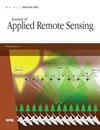Individual tree crown extraction of natural elm in UAV RGB imagery via an efficient two-stage instance segmentation model
IF 1.4
4区 地球科学
Q4 ENVIRONMENTAL SCIENCES
引用次数: 0
Abstract
The advancement of near-ground remote sensing and artificial intelligence techniques has revolutionized field surveys, replacing traditional manual methods. Nevertheless, understanding and exploring the growth patterns and intricate morphology of natural elm tree crowns present significant challenges, especially when attempting to extract their features, which are often susceptible to interference from surrounding grass and vegetation. In addition, existing detection and segmentation models based on convolutional neural networks exhibit redundancies in their network architectures and employ less efficient algorithms, such as mask region-based convolutional neural networks. As a result, these models may not be the most suitable options for analyzing extensive and highly detailed remote-sensing image data. We focus on detecting trees in semi-arid regions and extracting their canopy parameters, such as canopy width and area. A training set is established by outlining a total of 20,594 tree canopies on high-spatial resolution unmanned aerial vehicle images. A two-stage instance segmentation model is proposed to develop a method for individual tree detection and efficient extraction of canopy parameters in complex natural environments. The results demonstrate the method’s capability to accurately detect the location, number, and canopy parameters (e.g., crown width and area) of individual trees in diverse natural scenes. The model achieves a detection speed of 13.3 fps@1024, with the model weight parameters totaling 8.08 M and computation requiring 8.96 Giga floating point operations per seconds (GFLOPs). Moreover, the detection accuracy and segmentation accuracy of individual trees on the validation set are reported as 0.463 and 0.465, respectively. Compared with Mack RCNN and Mask Scoring RCNN, the proposed method reduces the weight parameters and computational complexity of the model by 82.4%, 83.5% and 96.8%, 92.8%, respectively, while increasing the inference speed by 47.4% and 26.3%. This method offers an efficient and accurate solution for obtaining the structural parameters of individual trees.基于高效两阶段实例分割模型的无人机RGB图像中天然榆树树冠提取
近地遥感和人工智能技术的进步彻底改变了野外调查,取代了传统的人工方法。然而,理解和探索天然榆树树冠的生长模式和复杂形态提出了重大挑战,特别是在试图提取其特征时,这些特征往往容易受到周围草地和植被的干扰。此外,现有的基于卷积神经网络的检测和分割模型在其网络架构中表现出冗余性,并且采用了效率较低的算法,例如基于掩模区域的卷积神经网络。因此,这些模式可能不是分析广泛和高度详细的遥感影像数据的最合适选择。本文主要对半干旱区树木进行检测,提取其冠层宽度和冠层面积等参数。通过在高空间分辨率无人机图像上对共计20,594棵树冠进行概述,建立训练集。提出了一种两阶段实例分割模型,为复杂自然环境下的单树检测和高效提取冠层参数提供了一种方法。结果表明,该方法能够准确地检测不同自然场景中单个树木的位置、数量和冠层参数(如树冠宽度和面积)。该模型的检测速度为13.3 fps@1024,模型权重参数总计为8.08 M,计算需要8.96 Giga浮点运算/秒(GFLOPs)。验证集中单个树的检测精度和分割精度分别为0.463和0.465。与Mack RCNN和Mask Scoring RCNN相比,本文方法将模型的权重参数和计算复杂度分别降低了82.4%、83.5%和96.8%、92.8%,推理速度分别提高了47.4%和26.3%。该方法为获取单株树的结构参数提供了一种高效、准确的解决方案。
本文章由计算机程序翻译,如有差异,请以英文原文为准。
求助全文
约1分钟内获得全文
求助全文
来源期刊

Journal of Applied Remote Sensing
环境科学-成像科学与照相技术
CiteScore
3.40
自引率
11.80%
发文量
194
审稿时长
3 months
期刊介绍:
The Journal of Applied Remote Sensing is a peer-reviewed journal that optimizes the communication of concepts, information, and progress among the remote sensing community.
 求助内容:
求助内容: 应助结果提醒方式:
应助结果提醒方式:


